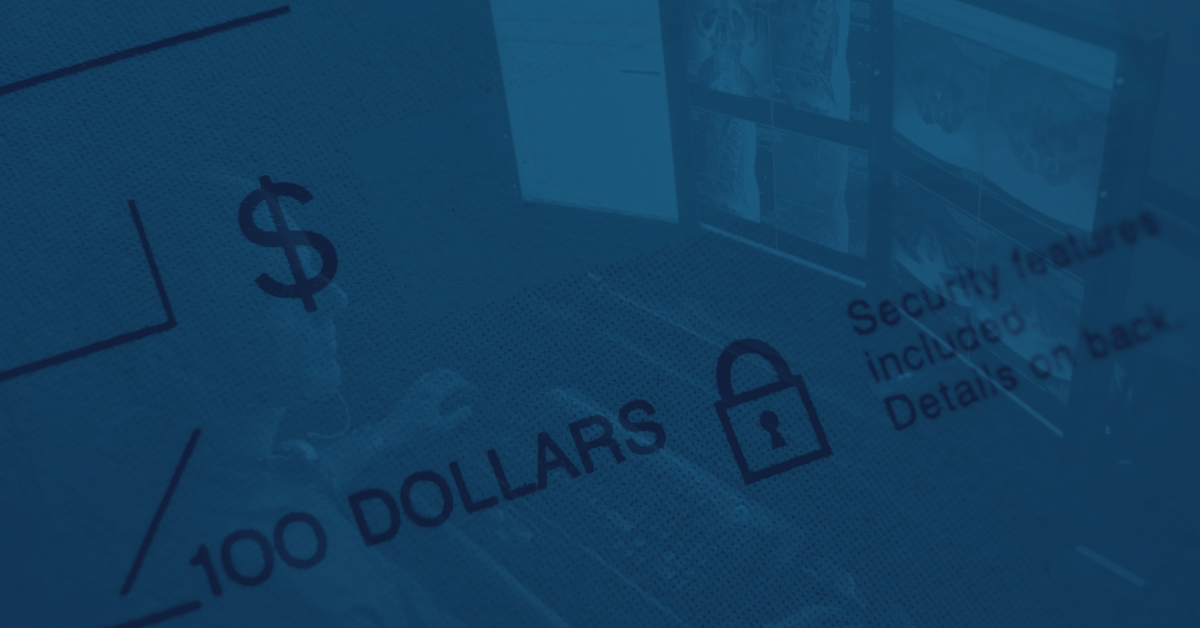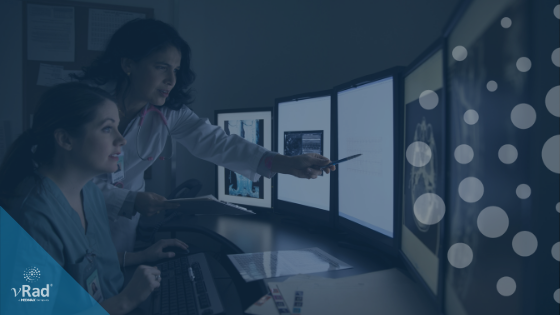8 Must-Know CV Tips for Radiologists—Whether Job Hunting or Not
If your Curriculum Vitae isn’t all it could be, you may as well be stacking trophies in a cave. I say this as a longtime radiologist recruiter who...

Remote radiologist jobs with flexible schedules, equitable pay, and the most advanced reading platform. Discover teleradiology at vRad.

Radiologist well-being matters. Explore how vRad takes action to prevent burnout with expert-led, confidential support through our partnership with VITAL WorkLife. Helping radiologists thrive.

Visit the vRad Blog for radiologist experiences at vRad, career resources, and more.

vRad provides radiology residents and fellows free radiology education resources for ABR boards, noon lectures, and CME.

Teleradiology services leader since 2001. See how vRad AI is helping deliver faster, higher-quality care for 50,000+ critical patients each year.

Subspecialist care for the women in your community. 48-hour screenings. 1-hour diagnostics. Comprehensive compliance and inspection support.

vRad’s stroke protocol auto-assigns stroke cases to the top of all available radiologists’ worklists, with requirements to be read next.

vRad’s unique teleradiology workflow for trauma studies delivers consistently fast turnaround times—even during periods of high volume.

vRad’s Operations Center is the central hub that ensures imaging studies and communications are handled efficiently and swiftly.

vRad is delivering faster radiology turnaround times for 40,000+ critical patients annually, using four unique strategies, including AI.
.jpg?width=1024&height=576&name=vRad-High-Quality-Patient-Care-1024x576%20(1).jpg)
vRad is developing and using AI to improve radiology quality assurance and reduce medical malpractice risk.

Now you can power your practice with the same fully integrated technology and support ecosystem we use. The vRad Platform.

Since developing and launching our first model in 2015, vRad has been at the forefront of AI in radiology.

Since 2010, vRad Radiology Education has provided high-quality radiology CME. Open to all radiologists, these 15-minute online modules are a convenient way to stay up to date on practical radiology topics.

Join vRad’s annual spring CME conference featuring top speakers and practical radiology topics.

vRad provides radiology residents and fellows free radiology education resources for ABR boards, noon lectures, and CME.

Academically oriented radiologists love practicing at vRad too. Check out the research published by vRad radiologists and team members.

Learn how vRad revolutionized radiology and has been at the forefront of innovation since 2001.

%20(2).jpg?width=1008&height=755&name=Copy%20of%20Mega%20Nav%20Images%202025%20(1008%20x%20755%20px)%20(2).jpg)

Visit the vRad blog for radiologist experiences at vRad, career resources, and more.


Explore our practice’s reading platform, breast imaging program, AI, and more. Plus, hear from vRad radiologists about what it’s like to practice at vRad.

Ready to be part of something meaningful? Explore team member careers at vRad.
6 min read
 Scott Baginski, MD
:
August 17, 2022
Scott Baginski, MD
:
August 17, 2022
.png)
You’ve found a position at another practice that you’re interested in, and they’ve reached out for an interview. Now what? Maybe it’s been years or even decades since your last interview, or maybe you’re just coming out of a residency or fellowship and this will be your first interview. I can share a bit about what to expect.
As one of three Medical Directors at vRad, interviewing potential new hires is an important part of my job. I’ve been in the role since June 2021 and with vRad for 10 years. Since then I’ve been interviewing up to five new candidates each week.
That means that I’ve spoken with hundreds of candidates, and can offer a few tips about what makes great radiologists stand out—not only at vRad, but at any practice.
An interview really is a conversation: a two-sided one! So, if you’re expecting me to ask all the questions and you to be on the hot seat trying to give all the “right” answers, you’ll be in for a surprise.
By the time your résumé reaches my desk, you’ve already been vetted through first-round interviews with our HR team. That means I’m less concerned about reviewing your qualifications or quizzing you on your accomplishments, and more concerned about whether or not your career aims and aspirations align with our practice. I really am just trying to get to know you and how you approach your work—and what you’re looking for in your next role.
We’ll talk about what our workflows are like, what help our vRad support and IT teams offer, what type of case mix you can expect, and what kind of schedule you’re looking for. Along the way, both of us should be trying to figure out if it’s a good match. You can ask questions, too—and you really should! This is your time to make sure that you’re getting what you’re looking for in a radiology practice. Be yourself and know your motivation. That helps to make for a more meaningful conversation.
Two of the most important pieces of information that I’m looking for in the interview are why you’re looking to leave your current job, and why you’re looking to work at vRad in particular. That helps me understand your motivations and gives me confidence that you’ve put some thought into whether vRad is the right place for you.
Ideally, you’ll be able to explain some of the pain points in your current job and how vRad may help solve those for you. A sincere explanation of your thought process goes a long way.
Additionally, it would be a red flag to me if I speak to someone who says they want to read exclusively musculoskeletal MRIs. That’s just not what we are. We are primarily an emergency radiology practice. I’d say our modality mix is about 60% CT, 30% x-ray, 8% ultrasound, and 2% MRI/Nuc Med. They’re not going to be happy here, and we don’t want to employ someone who’s not going to be happy.
By the time you’ve spoken to me, you’ve already talked with our recruiters and gotten past a first-round of interviews. That means you should already know quite a bit about the practice.
It’s always a best practice to look at any documents or videos the practice sends you before or during the application process. For example, after first-round interviews, we send our candidates videos of radiologists working on our platform; it gives them a really accurate feel for our system and our process. I expect candidates to watch those before they speak with me, and I would be concerned if it’s obvious that they didn’t.
4. Demonstrate that you care about quality.
For radiologists, it’s admittedly hard to communicate in an interview that you’re good at what you do. But what you can communicate is that you care about what you do, and that you’re on board with the goal of doing high-quality work.
One way that I gauge how people feel about the importance of accuracy is through their reaction to our rigorous quality assurance (QA) process. We don’t view QA as a threat (we know that everyone makes mistakes sometimes) and it’s not intended to be punitive. It’s really a tool that helps make sure we’re providing accurate reads and helps radiologists improve. We’re all in this to do good work, and QA just makes sure we’re getting things right. When I talk to people who feel the same way, it’s usually an encouraging sign that they’re on board and have a mature attitude about the process. I love when people view QA as a learning opportunity.
Alternatively, when people get nervous or defensive about QA, it makes me think twice about their approach to radiology. If they view it as a personal attack, they might not be the right fit for us.
I always ask prospective rads what their ideal schedule looks like. It’s not a trick question and there isn’t any “right” or “wrong” answer. I’m just trying to figure out how you’ll fit into the practice and offer you a more accurate picture of what the workload will look like.
When considering your future schedule needs, be sure to take into account your lifestyle. It differs for everyone. For example, a single parent with kids at home vs. an empty nester experience very different demands on their time. It is a positive sign when a candidate has clearly thought through these things as it relates to their schedule. Who depends on you? What is your support system?
Case mix will play a role as well. For example, someone who wants to read nights will see a lot of emergency radiology cases, while someone who wants to work days will see a lot of outpatient non-emergent cases. If you tell me that you can’t stand reading pulmonary nodule follow-ups but you want to work daytime hours—well, that’s probably not going to be a great match.
That being said, we view our flexibility as one of our greatest assets. While we do expect rads to commit to their schedule, they have a lot of say over what that schedule looks like.
Some candidates make the mistake of thinking that fitting into the “practice culture” is irrelevant — but it’s most definitely not.
For example, we have a practice culture where rads are supportive of one another. When you need a second opinion, you can easily and conveniently consult another rad through our internal platform. We may be a virtual community, but we’re still a community and we help each other out. We get to know each other, learn from each other and rely on each other. In any position, we all need to know we have colleagues available when we need them—even if they are not in the desk or office next door but many states away.
We also believe in fairness, and we reflect this in the way we assign cases. We have a computerized process that assigns and prioritizes cases, putting them into different rads’ queues in a way that makes sure the most urgent cases get read right away. In the interview, I’m looking to see how people react to that process. Most of the time, they view it as a positive: it takes away the anxiety of having to figure out which cases are most urgent, and it prevents cherry-picking. But occasionally, people will bristle at the idea of not being able to pick their own cases or send back “hard” cases. That’s a red flag to me, because it’s just not in line with the way we work here.
While compensation probably isn’t the first thing you want to bring up in an interview, we absolutely expect it to be a point of discussion. Don’t feel like it’s taboo: you need to get paid. We want to pay you, and we try to be incredibly transparent about how our payments work. Any practice that doesn’t want to engage you during the interview about how much you’ll make should be a red flag for you.
At vRad, it’s pretty straightforward: we pay based on production, so the more cases you read, the more you get paid. If you know how many cases you usually read and you give those numbers to us, we can give you a number back. You can get your case logs and really get an understanding of how much you can expect to make here. We’re also happy to talk in more general terms about how much the average radiologist makes. It’s such an important topic, and we don’t begrudge anyone for wanting to have an open conversation about it.
Sometimes people focus so much about what reading looks like that they forget to ask about administrative duties. I talk to a lot of rads in traditional practices—especially ones in the beginning of their careers—who didn’t realize just how much time they’d be spending on things like serving on hospital and practice committees, driving between sites, attending tumor boards. Now they are looking to spend more of their time just reading.
So make sure to ask what you’ll be expected to do outside of your reading duties. That will give you a more accurate picture of what your day-to-day will look like. (Spoiler alert: at vRad, there’s almost no admin work.)
I always enjoy talking to prospective employees about career opportunities and the quality of life at vRad. If you’d like to speak to me directly, please submit your information and mention my name. I’d be happy to share my experience and answer your questions.
Back to Blog
If your Curriculum Vitae isn’t all it could be, you may as well be stacking trophies in a cave. I say this as a longtime radiologist recruiter who...

1 min read
One of the first questions any radiologist has when exploring a new opportunity is about salary. It's an important question. At vRad, some...

For the latest information on vRad’s Artificial Intelligence program please visit vrad.com/radiology-services/radiology-ai/ Early hype implied that...
vRad (Virtual Radiologic) is a national radiology practice combining clinical excellence with cutting-edge technology development. Each year, we bring exceptional radiology care to millions of patients and empower healthcare providers with technology-driven solutions.
Non-Clinical Inquiries (Total Free):
800.737.0610
Outside U.S.:
011.1.952.595.1111
3600 Minnesota Drive, Suite 800
Edina, MN 55435